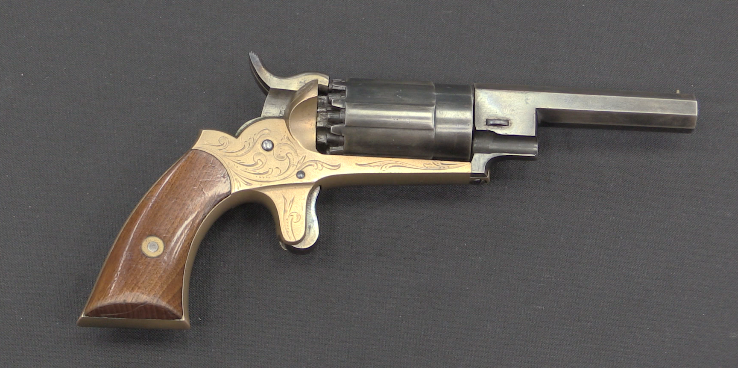Today we will take a look at the history of Springfield Armory – both the American national arsenal founded in the 1770s and the commercial entity founded in the 1970s.
Related Articles

Ammunition
Book Review: Bullets by the Billion

Revolver
Walch Double-Shot Revolver at RIA

Grenade Launcher

My M1 is a W W II Springfield and my 1911 is a 1980’s Springfield so I have one from each. My 1911 frame has F1 Brazil on it.
Keep your powder dry and your faith in God.
Very nice summary, I think.
The mention of Shay’s Rebellion provides an interesting entry point into U.S. history. The United States of America did not exist when Shay’s Rebellion occurred, and the rebellion was an important influence on the decision of the States to convene a Convention to reform the Articles of Confederation (because, for example, rebels who fled to Vermont were safe from Congressional capture because there was no means within the Confederation to compel a State to turn someone over – there was not a “Federal” authority). Of course the Conversation mention that eventually occurred in Philadelphia went beyond offering reforms to the Articles and offered instead a new Constitution, which eventually was ratified and created what we now call the United States of America. The constituency that sparked Shay’s Rebellion (primary rural, farming population) was greatly under-represented in the Convention that created the Constitution and we live today with divisions along those fault lines.
Whoops, auto-corrupt of text put “Conversation mention” where I wanted to have Convention in the above.
Today we should be better represented in our government but it appears that politicians of all parts of the American political spectrum listen mostly to corporate fat cats, which explains why they can be millionaires despite their nominally average middle class paycheck mandated by the laws of the land (money under the table seems to buy lots of votes nowadays). This applies only to those who have served multiple terms consecutively in either the House or the Senate, not to the minor one-term nobodies… or am I wrong?
There’s full confirmation of that.
Gilens and Page, I think it was 2012, looked at legislation, there finding confirms what has probably always been the case.
Individual voters have zero influence, it’s the big organised special interrest groups.
The paper is all the more surprising as the authors are (or were) at Princeton. OK, it’s not as heart of the establishment as Harvard, the council for foreign relations or the trilateral commission, but still…
Defence spending is one of those areas where money flows straight from hard pressed tax payers pockets and into billionaires pockets. Politicians who facilitate that can go far.
Of course I’m probably wrong, but there is a slight possibility that one or two of those politicians didn’t just exist in a vacuum, springing up fully formed as a Full-Time Politicians from the head of a pre-existing Full-Time Politician. Let’s pretend that many of these Full-Time Politicians were originally business owners, and frequently relatively successful ones, BEFORE they became politicians, and frequently belonged to families with a fair amount of money as well (which helped them start their business and send them to school, often enough), and the fact that they were upper middle class and had a certain amount of money of their own is WHY they were able to convince people to vote for them, and to help kickstart their own campaigns. Most of them don’t STOP owning their businesses on the side just because they become politicians either, unless it looks like it would be a liability to public image. Most also are smart people who are able to use the stock market and buy and sell property, and other ways in which people can grow a decent salary into much more.
Is there corruption and kickbacks? Sure, obviously, there often is. But I don’t see where people like you get this idea that “that politician is a millionaire, he/she must be corrupt and taking kickbacks!” I’m pretty sure you will find in most cases they were quite well off BEFORE they became politicians, and that’s often directly tied to why people were willing to vote for them. For some reason people…rich and poor….are more comfortable voting for someone who can make, or at least not loose, a decent amount of money and afford a “good education” as opposed to a guy who’s lower middle class and works as a plumber. It helps on a number of levels to come from a family with money. That’s how it is, for right or wrong. There is no requirement to give away all your wealth to take public office, no requirement that you give up all sources of income other than your official salary (although it’s generally expected that you place control of the business into trust).
“That politician is worth $30M and he only makes $600K a year: clearly corruption is to blame!” is not the smoking gun you think it is by a long shot. Use a little logic.
You’ve got that a bit mixed up Enzer. The United States existed. The U.S. Constitution did not. That was still the name of the country under the Articles of Confederation (ratified March 1, 1781). As you correctly pointed out, Shays Rebellion (summer of 1787)helped push for changes to the Articles of Confederation and ultimately the Constitutional Convention which gave us our current system of government.
Is this still a site devoted to weapons design, history
and technical explanation? Or did it morph into
another dump of political claptrap?
Our apologies, but sometimes things came into being no thanks to the stupid politics. I’m not advocating anarchy. Would you like to procure your weapons (in bulk) from institutionally certified armories or from backyard blacksmiths who may not actually have the proper tooling for your commissions? I’m very certain few local blacksmiths with the tools of the late 18th Century could produce military grade muskets on the production level needed to equip an entire regiment of soldiers. For that matter, the Austrian Lorenz rifled musket made during the middle of the 19th Century was an example of mass subcontracting gone bad, where many of the locally made examples didn’t have interchangeable parts (and many had inconsistent bore diameters and misaligned barrels/stocks, and horribly skewed iron sights).
Contra examples exist as well
The Mauser Werke, DWM, Ludwig Lowe, Fabrique National and BSA were all private concerns with unrivalled reputations for excellence.
The production version of the British SA80 an almost entirely state run programme? Less so.
Poor supervision of contracts is easy, just look at the numerous state sector computer system fails.
To the best of my knowledge, non of the private manufacturers I listed, had the organisational nor technical problems that Hatcher’s notebook described for the “low number” M1903 rifles.
Hatcher’s listing of the manufacture dates of the rifles which actually failed, contradicts his assertion in the text that this was a wartime problem.
The problem existed long before the war, and, because the steel and heat treatment specs and practices were carried over from the M1895, it appears likely that the problem was present in that rifle as well.
Keith, all the private manufacturers you named are proper firms. I was talking about the difference between contracting to proper firms and contracting to people who probably can’t even read! In the case of the Lorenz production problems, there was little official oversight or auditing to ensure quality control was in place. And must we mention the horrible example of Remington rifle contracts from Imperial Russia where the state/customer had idiotic requirements alongside the sensible ones? I mean, seriously, rejection of rifles just because the wood grain doesn’t look good in a photo?
You’ve got me thinking about the rockers, van Halen and their “brown M&M clause”
It provided a quick check on whether the other party had understood, or even read the contract that they’d signed up to.
Properly done, a contract clearly lays out what is expected of each party, and means of settling any disputes or problems which arise. It’s imperative that all parties read and understand what they are signing up to.
I’m guessing that the Tzarist inspection team found that their bowl of M&Ms contained brown ones.
Same in Spain.
CETME’s B and C had a good build quality and materials. CETME L not so much (very bad from 1995 onwards), and most of the AMELI production was junk.
All in the same entity.
I live about 15 miles away from Springfield, Mass. I always wondered about the power sources of the Armory, and never got a chance to go there and check it out. Thank you.
I’m about 100 miles north and west of Springfield. I have been to the museum a few times,you really should go. So worth the time spent.
Harpers Ferry wasn’t quite as insignificant to American history as one might think.
Many weapons trials were conducted near Washington, and (prior to the Civil War) it was Harpers Ferry that often supported them. The Ordnance Department was also located in Washington.
Large numbers of weapons were manufactured at Harpers Ferry.
Manufacture of George W Morse’s new centerfire cartridge rifles was begun at Springfield Armory, but moved to Harpers Ferry. Had the outbreak of the Civil War not resulted in the gutting of Harpers Ferry, these remarkable weapons may have begun the metallic cartridge revolution instead of the rimfire Spencer.
But, the most important contribution of Harpers Ferry was the true introduction of mass production. When John H. Hall managed to convince the Ordnance Department and Congress to let him prove his ideas for mass-manufacture and interchangeable parts, he wanted to set up at Springfield. They had him set up at Harper’s Ferry instead. Despite a great deal of interference from the Superintendent James Stubblefield, Hall’s project was an amazing success and the true beginning of mass production, interchangeable parts, and machine tools. (Eli Whitney gets credit for it, but he failed. It was Hall that made it all work.) For years later, he worked with other manufacturers (Samuel Colt, Simeon North, Eli Whitney …) to change way everything would be manufactured.
Part of the problem was Springfield Armory had a split personality. It worked developing weapons and engineering up the production. And as a production facility. So the workman were pulled 2 ways. Plus the fielding of the M-14 was so screwed up, that at the time of the Berlin Wall going up, the US FArmy in Berlin still were using M-1’s they hadn’t gotten around to getting them issued.
One more thing, Your Garand and 1903 on the wall, the cotton web slings are not properly adjusted. You might want to think about doing a show on how the 1905 leather sling was/is used to steady a rifle, and how the web sling does it, slightly differently.
As a historical note it is perhaps worth mentioning that the first permanent or at least semi-permanent state armories were established by the Romans during the Imperial era. They were typically regional and manufactured weapons and equipment for the legions stationed in the area.
It is not known if the manufactories were all state owned (or rather property of the Emperor). Some may have been established originally by local blacksmiths and bladesmiths, but certainly the funding came from the Emperor. In the East Roman (Byzantine) Empire such “state” manufacturing shops of arms and armor continued to exist all the way to at least the Komnenian period (12th Century).
Excellently presented narrative; well fitting in connection with some arms which were introduced here. I think it my be pertinent to mention another superseded icon of American riflemaking – Winchester Arms. I was lucky to see it still operating. Remington is not far from bankruptcy – yet again. One day it will be the case with Colt.